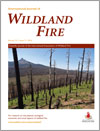
International Journal of Wildland Fire
Volume 23 Number 2 2014
WF12161Hydrologic and erosion responses to wildfire along the rangeland–xeric forest continuum in the western US: a review and model of hydrologic vulnerability
This paper reviews the potential hydrologic and erosion consequences of increased wildfire activity associated with cheatgrass invasions, plant community transitions and warming climate along the rangeland–xeric forest continuum in the western United States. A conceptual model of post-fire hydrologic vulnerability and risk is presented and key knowledge gaps that limit post-fire risk assessment are identified.
WF13024Forecasting fire activity in Victoria, Australia, using antecedent climate variables and ENSO indices
Can bushfire activity be forecast using climate variables? We review the relationship between fire activity, climate variables and El Niño–Southern Oscillation (ENSO) for the fire-prone state of Victoria, Australia. The results reveal the potential to use climate variables and ENSO indices to forecast the upcoming season’s potential bushfire activity.
WF13014Changes in forest fire danger for south-western China in the 21st century
Future changes in the fire danger rating and the forest fire season were predicted for south-western China under two scenarios. The fire season will be prolonged by an average of 28–31 days and potential burnt areas will increase by 19–23% by the end of this century.
WF13002Characterising weather patterns associated with fire in a seasonally dry tropical forest in southern India
We examined the predictability of fire days in a seasonally dry tropical forest in southern India using weather parameters. Fire days were more likely with low rainfall in the early dry season, low relative humidity and high temperatures during the dry season. We provide a quantitative framework for fire risk assessment for this forest type.
WF12186An evaluation of fire danger and behaviour indices in the Great Lakes Region calculated from station and gridded weather information
A website integrates weather, fire danger and fire behaviour information for the Great Lakes region of the United States. Applications of this Great Lakes Fire and Fuels System are demonstrated and evaluated for the 2012 fire season.
WF13138Mapping day-of-burning with coarse-resolution satellite fire-detection data
It is often necessary to know what day any given area has burned to allow for incorporating daily weather data into fire-related analyses. I evaluated several methods for interpolating coarse-resolution day-of-burning satellite data into fine-resolution maps. The resulting maps showed reasonably high quantitative and qualitative agreement with fire progression data.
WF13086Estimation of forest structure and canopy fuel parameters from small-footprint full-waveform LiDAR data
Knowledge of fuel conditions is critical to accurately forecast fire behaviour. We present a methodology to estimate forest canopy fuel parameters using small-footprint, full-waveform light detection and ranging (LiDAR) airborne data in a mixed forest region of north-west Oregon (US).
WF13053Fire regime shift linked to increased forest density in a piñon–juniper savanna landscape
Tree-ring reconstructions reveal historically frequent, low-severity fires (mean fire interval = 7.8 years, ≥2 sites scarred) and low tree densities (mean = 135 trees ha–1) in a piñon–juniper savanna in the south-western USA. This differs dramatically from (1) current conditions and (2) other piñon–juniper ecosystems containing less grass cover.
WF12081Songbird response to wildfire in mixed-conifer forest in south-western Oregon
We evaluated the effects of a 2500-ha wildfire on bird abundance in a southern Oregon mixed-conifer forest. Over 4 years after the fire, birds associated with conifer tree canopy decreased and birds associated with broadleaf shrubs increased.
WF13031Large airtanker use and outcomes in suppressing wildland fires in the United States
We integrate multiple datasets to characterise the use of large airtankers in fire suppression efforts on federal land for the conterminous United States in 2010 and 2011. Results confirm earlier work suggesting extensive use of large airtankers on extended attack, despite policy stating priority for use in initial attack. Further, results suggest that initial attack success rates for fires with large airtanker use are relatively low compared with the success rate on all wildfires.
WF13029Air tanker drop patterns
Ground patterns of liquid aerial drops for combating wildfires (airplanes and helicopters) are considered. Based on a significant number of drop tests, a simple model for the length, the width and the coverage distribution is presented. The difference between gravity systems and recent pressurised systems is also discussed.
WF12106Social preferences for fuel break management programs in Spain: a choice modelling application to prevention of forest fires
This article presents an economic valuation study of several aspects related to the management of fuel break networks. It shows how citizens’ welfare is influenced by eventual changes in fuel break management programs that have to do with the cleaning techniques employed, the design and overall, with the potential to reduce fire risk.



